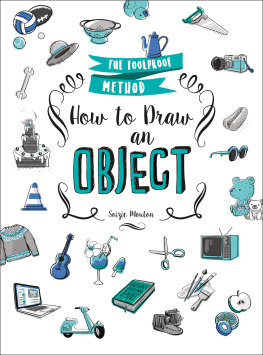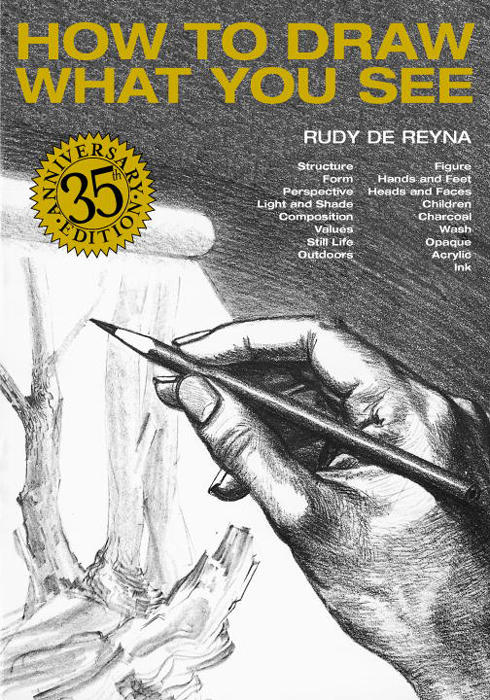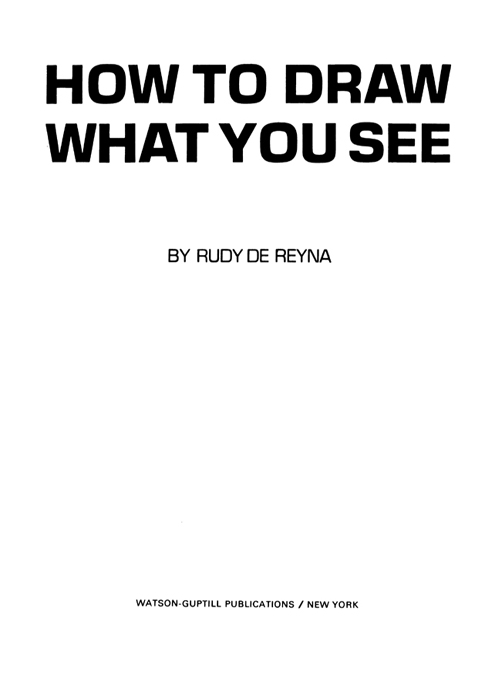Library of Congress Catalog Card Number 72-152754 Pb ed.
eISBN: 978-0-307-78635-7
All rights reserved.
I would like to express my appreciation to my editor, Diane Casella Hines, who was my invaluable silent partner in bringing this book to completion. Like a master carpenter, she patiently assembled the pictures and text, trimming here and smoothing there, until all the pieces fit. With an editors special gift for putting herself in the readers shoes, she scrutinized and polished each sentence until it was as clear as she could make it. She has accomplished this task with ingenuity and dispatch, and I am extremely grateful.
Part One: Fundamentals of Drawing
I believe that you must learn to draw things as you see themrealistically. That is, you must reproduce the dimensions and proportions of a given subject. To render a faithful, realistic drawing, you must be able to observe the basic structure of an object, regardless of how complex and obscured by detail it may be. You must train not only your hands but your eyes as well.
However, the ability to depict an object literally doesnt make you an artist. No one ever claimed that the faithful duplication of nature (an impossible task anyway) produces art. But the ability to draw things as you see them is the first step toward becoming an artist.
In other words, throughout this book youll learn to draw realistically. The objects before you will dictate what you should do, and the result will be the literal representation of the object. When youve finished the projects in this book, youll be equipped with the necessary skills to enable you to express yourself as an artist. Having learned the fundamentals, the craft of drawing, youll have a solid point of departure from which to create. Then, if you wish, you can leave the literal imitation of a subject to the students behind you.
PROJECT 1
Basic Structure of Objects
Every object that you see has a structure or form based on either the cube, the cylinder, the cone, or the sphere. Any object may be based on one or a combination of these four geometric solids. A solid, for our graphic purposes, means an object that has three dimensions: height, width, and depth.
Basic structure doesnt mean that things are geometrically perfect cubes, cylinders, cones, or spheres. (They can be, of coursefor example, a square box, a round can, or an ice cream cone.) It means that objects are based on these four geometric solids. The shape of the object is modified in various ways that depart from the strict geometrical form ().
This principle was a revelation to me. I found that I could concentrate on overall dimensions of an object; then, at my leisure, I could add whatever details I wanted to include. In addition, because the four basic geometric forms are solid, i.e., three dimensional, you get a feeling for the bulk and the weight of everything you draw.
In the next three projects, well explore the first of these basic formsthe cube. Well flatten it down, pull it up, or lengthen it, depending on our needs for representing an actual object (drawing the straight lines that form them.
Drawing Straight Lines
All you need to do the exercises in this project is a standard office pencil and a pad of drawing paper. Ive used a KOH-I-NOOR #555, grade #2 pencil, and a #307 Ad Art layout and visualizing pad made by the Bienfang Company.
The range of pencils and drawing papers is so wide that I wont even attempt to enumerate them. Actually, for your first explorations, almost any pencil and any type of paper will do. Later youll be more discriminating.
Drawing Lines Freehand
Since the first objects youre going to draw require primarily straight lines, lets look into ways of making them without any mechanical aids. I want you to draw them freehand; its awkward and impractical to be encumbered with rulers and triangles as you sketch, especially outdoors. Besides, theres a certain life and vibrancy to a line drawn freehand when compared to the cold and mechanical line made with a ruler.
Holding the Pencil
Drawing a straight line, despite the old saw about it being awfully difficult, is easy and fun to do if you use the right approach (). Begin this very moment. Dont procrastinate. It doesnt matter in the least if the way you hold your pencil isnt the same as mine.
Hold your pencil in the usual writing position or under the palm, whichever feels more comfortable (). Swing the straight lines from the elbow, not from the wrist. Swinging from the wrist will make your stroke too short and your line will be choppy and labored.
Angle and Direction of Lines
By practicing, youll discover the best angle at which you can draw a straight line. Then, all you have to do is turn the paper to execute a horizontal, a vertical, or a diagonal line. Try them all. My own personal choice is in a northeasterly direction, beginning at the southwest. Your favorite direction may turn out to be the same or it may be a horizontal line that runs from west to east. The direction of the line isnt important. Its the spontaneity and directness of the line that really matters.
Dont be timid and make short stabs at drawing lines. Dash them off with one stroke. No one is going to see or evaluate them. Relax. Let yourself go, and swing away so that you can limber up your entire arm. If you can draw a straight line in any directionwithout turning the paperyoure to be envied. Find out right now if youre one of the fortunate few.
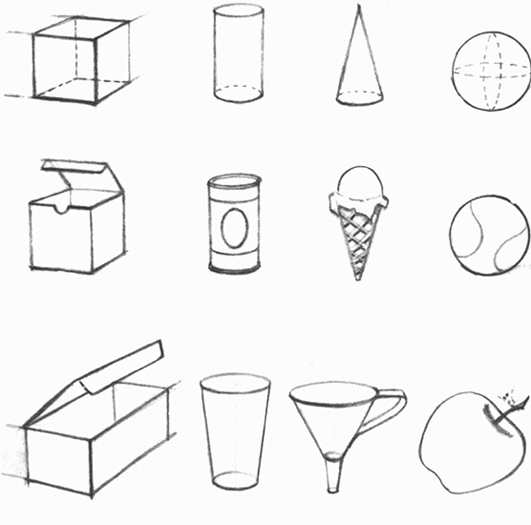
Figure A. Actual objects can conform rigidly to the four basic formscube, cylinder, cone, and sphereas shown in the top two rows. Usually, however, theyre only based on these geometric forms. As shown in the bottom row, the box is elongated but still cubic. In the tumbler, the cylinder form is tapered; in the funnel, the cone shape has been truncated; and the apple, despite its bulges and indentations, is still basically spherical.
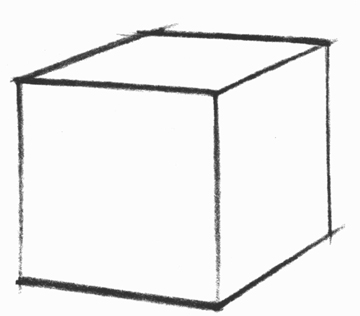
Figure B. This is the geometric cube, with its six sides all exactly the same size.
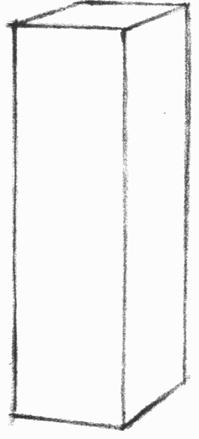
Figure C. This is a cubic form. Its no longer equilateral, because four of its sides are rectangular and its ends are square, but its still based on the cube. Its like a quarter pound of butter.


